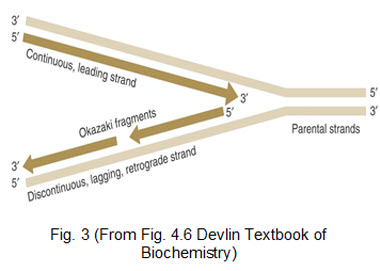General Features of DNA Replication
DNA replication is the semi-conservative synthesis of the cellular double-stranded DNA (parental molecule) to produce two double-stranded daughter molecules. Each one of the daughter molecules contains one parental strand, and one newly synthesized strand (Fig. 1, below). Therefore the process is said to be semi-conservative.

Replication proceeds in a 5' to 3' direction starting at specific origins
DNA molecules are built with nucleotides linked by phosphodiester bonds joining the 5'-OH group of one nucleotide to the 3' OH of the next. Thus, a linear DNA molecule has directionality (or polarity) such that one end of the molecule has a 5'-OH group and the other end a 3'-OH group and is referred to 5'- and 3'-end, respectively.
Each new strand is synthesized using deoxyribonucleoside triphosphates (dATP, dGTP, dTTP, dCTP) as substrates. Nucleotides are added in a 5'----->3' direction, with anti-parallel complementarity to the sequence of each parental strand, which is termed the template. DNA polymerases catalyze the polymerization reaction.
Initiation of DNA synthesis requires a RNA primerDNA polymerases cannot initiate synthesis of a parental chain using a free dNTP(N=A, G, C, and T) as the first substrate. They have to add dNTPs onto an RNA primer or an existing DNA segment. The primer provides a free 3'-OH group for the incoming nucleotide to form a phosphodiester bond. The dNTP is added as its monophosphate residue, leaving pyrophosphate as the other product of the reaction (Fig. 2, below).

|
Replication occurs bi-directionally from the origin of replication (initiation site). DNA polymerase can only add deoxyribonucleotide residues in a 5' to 3' direction. Therefore, as replication proceeds in a given direction from the origin, one of the daughter strands (leading) is synthesized continuously. The other daughter strand (lagging) is synthesized discontinuously as short segments of DNA that are called Okazaki fragments (Fig. 3, right). The Okazaki fragments are later joined to form a continuous DNA strand.
|
|


